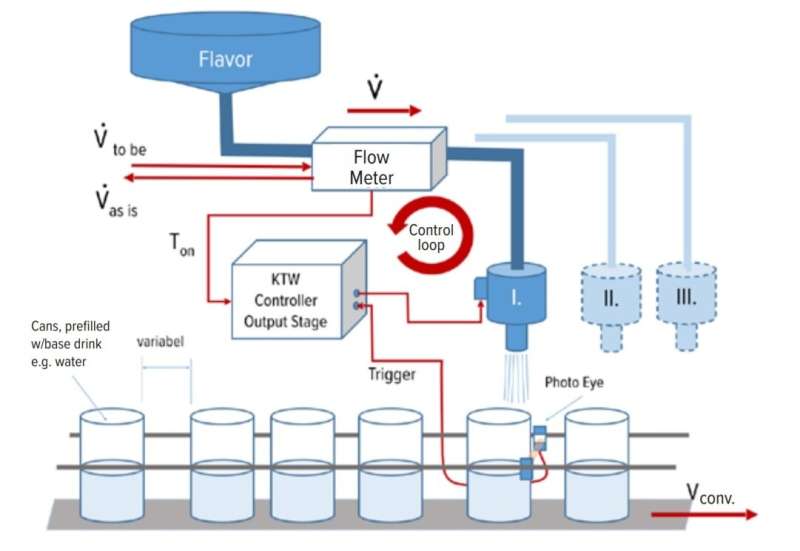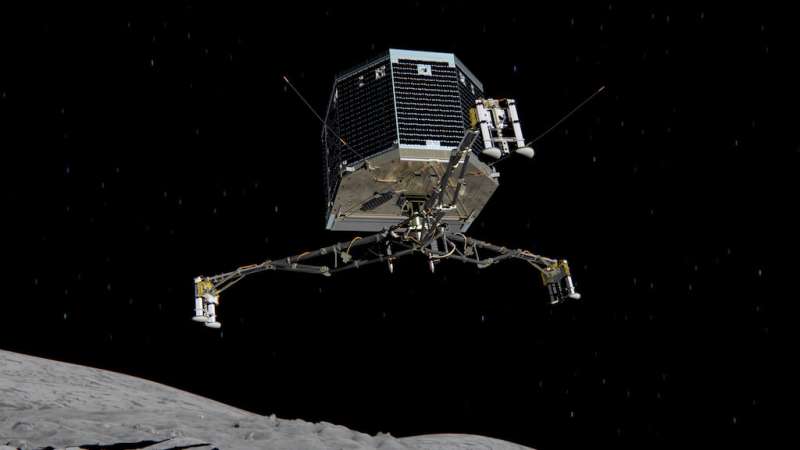Spacecraft magnetic valve used to fill drinks

A precision magnetic valve originally designed to help steer a lander down to a comet has found a surprise terrestrial use through ESA's Technology Transfer and Patent Office: adding flavors to beverages within a few thousandths of a second per each can or bottle.
Modern filling carousels for beverages are already miracles of automation, typically capable of filling hundreds of bottles, cans or cartons per minute. But these complex systems are optimized for single, large production batches. Meanwhile the market is moving on.
"Visit any supermarket today and you'll see a vast variety of different beverages on offer, from energy drinks to flavored waters," explains Wolfgang Teichmann, managing director of KTW Technology.
"But traditional filling systems are not able to keep up in an efficient way with this widened product portfolio. Switching between filling different products requires prolonged downtime to get pipes dry and clean, because manufacturers do not want leftover flavors contaminating their next batch.
"Instead, our aim has been to create a solution where fewer, faster dosing valves could be used to deliver the flavors as a concentrate at the end of the filling process, making systems more flexible and energy-efficient, and significantly reducing the time and resources lost during cleaning."
The target was to design a more efficient and sustainable solution. To make this possible, KTW has made use of space technology: a quick reacting precision valve that, unusually, has just one moving part—a ball that sits in a 'valve seat," keeping the valve closed until moved by a magnetic field to open it within a thousandth of a second, or millisecond.
Based on its "SmartValve' technology KTW´s High-Speed Precision Dosing system can provide incredibly accurate doses of between 0.1 and 3.0 ml, typically used to add flavor to a prefilled 'base liquid' such as water and specially designed to minimize wasteful splashes. The valve technology is in addition the base technology for several industrial solutions, made by KTW, to increase efficiency and reduce emissions, pesticides or waste.
In fact the magnetic valve was originally designed for just this purpose by space engineer Dietmar Neuhaus of the German Aerospace Center, DLR. His aim was to achieve precision maneuverability of satellites using 'cold gas thrusters," where small amounts of gas are released to gain movement, like letting go of a balloon. The idea was initially proposed for the Rosetta spacecraft's Philae lander, although in the end an alternative method was selected.
"This valve design has a number of benefits over traditional designs, including those with springs," explains Dietmar Neuhaus. "With only one moving part, it has a very long lifecycle. Its direct switching function means it is extremely quick to react to the incoming signal and very precise in the dose it delivers."
With the help of EurA, one of ESA's technology brokers in Germany, KTW developed the idea to use and to develop furher the valve technology . Its development was subsequently supported through an ESA Technology Transfer Demonstration project.
Wolfgang Teichmann adds: "In a typical beverage dosing system, you would normally have a carousel with lots of valves—often over a hundred—to fill the containers with the final liquid, whereas with our solution you only need one to three valves providing microdoses of the concentrate at the end of the line. Speed and precision are vital; we can fill up to 120 000 cans per hour.
"Longevity is also important in the filling industry. Valves typically have a short lifetime, whereas our valves, with just one moving part, have been shown to last for over 10 billion doses, and require less maintenance. And when any is needed, the fix is quick and simple, taking minutes instead of the weeks needed for a standard system repair. It simply just be a matter of exchanging the ball and valve seat."
KTW's High-Speed Precision Dosing System can either be integrated within an existing production system or deployed on a stand-alone basis.

"As a company, we're motivated to boost efficiency, reduce waste and increase sustainability, following our slogan "SpaceTech 4 Planet Earth,'" notes Wolfgang Teichmann. "So for instance our Air Flow Saver system allows users to save up to 90% of their compressed air use: German industry spends 4.5 billion on using compressed air annually, which costs eight to 10 times more than conventional power sources.
"Giving an idea how it works in practice, a customer might use compressed air to dry out a Tetrapak label before its filling date is added. Normally this compressed air is left blowing continuously, but our system only opens the valve to release air when a vision sensor shows a label is present, for just 30 milliseconds at a time. When passing five Tetrapaks per second the blow off station, it will save 85% of compressed air. And as we are pulsing in real-time, this blowing increase the drying effect."
Provided by European Space Agency





















